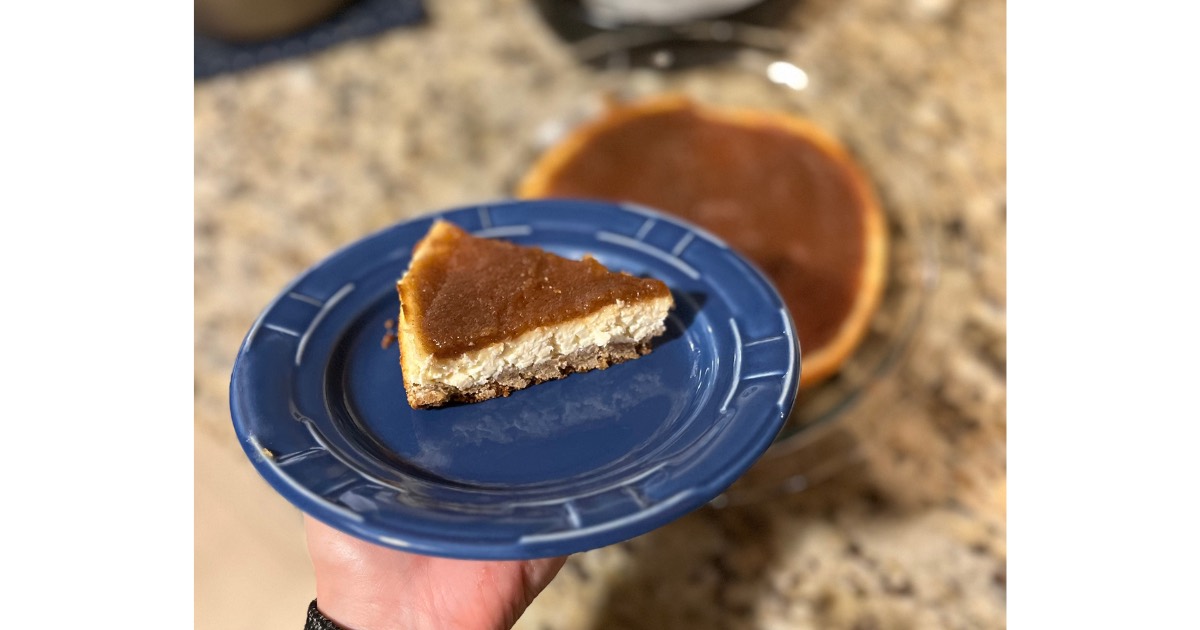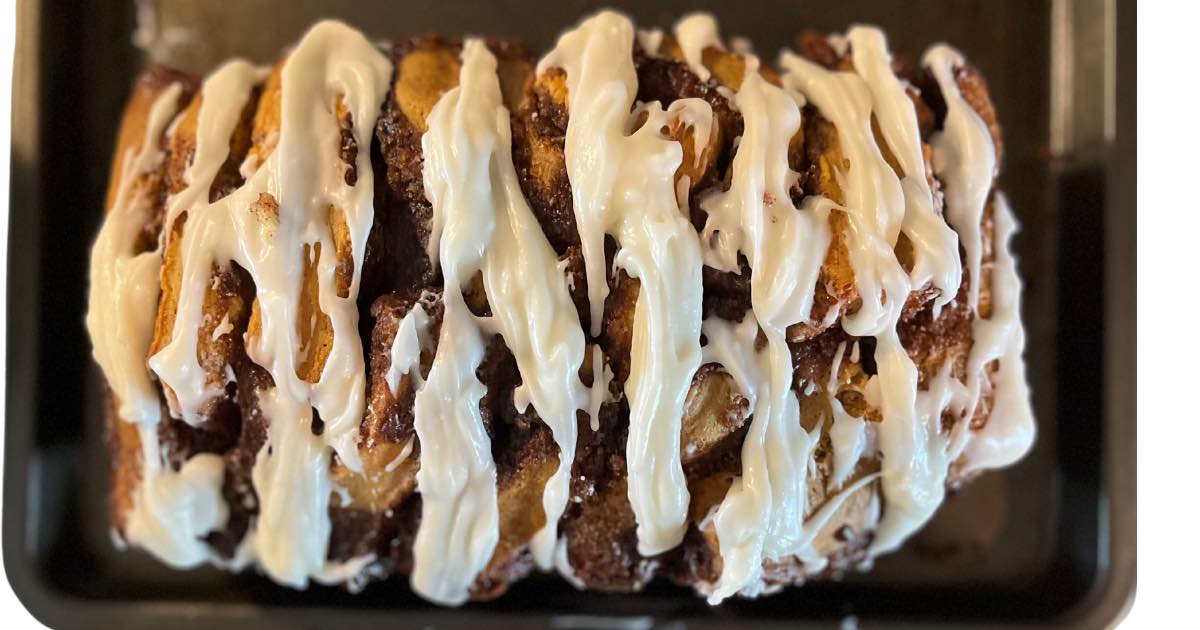Is there anything better than a homemade sourdough bagel? In our minds, nothing beats a good chewy, made from scratch bagel in the morning.
The thought of making homemade sourdough bagels from scratch always intimidated me. I did not understand how to shape dough or what the purpose of a salt bath was. After the first time I made them, I was hooked!
Making homemade sourdough bagels is extremely easy to make from scratch. Once you make these bagels from scratch, it’s like having a bagel shop in your own home! The recipe is highly adaptable and can be made overnight or stretched out for a long fermented bagel dough for those of us who may be more sensitive to gluten (woo hoo to more sour flavor!).

Whether you use this homemade sourdough bagel recipe as a base for a sweet or savory bagel or enjoy them plain, this a versatile recipe. With the ease of add-ins like chocolate chips or sun dried tomatoes, there is no end on ways to enjoy sourdough bagels (we even have a round up of 20+ of the best bagel recipes)!
And the amount of toppings which can be added makes even more flavorful combinations. Butter, cream cheese, peanut butter, eggs, avocado. The list goes on and on. So let’s get to the recipe, shall we?!
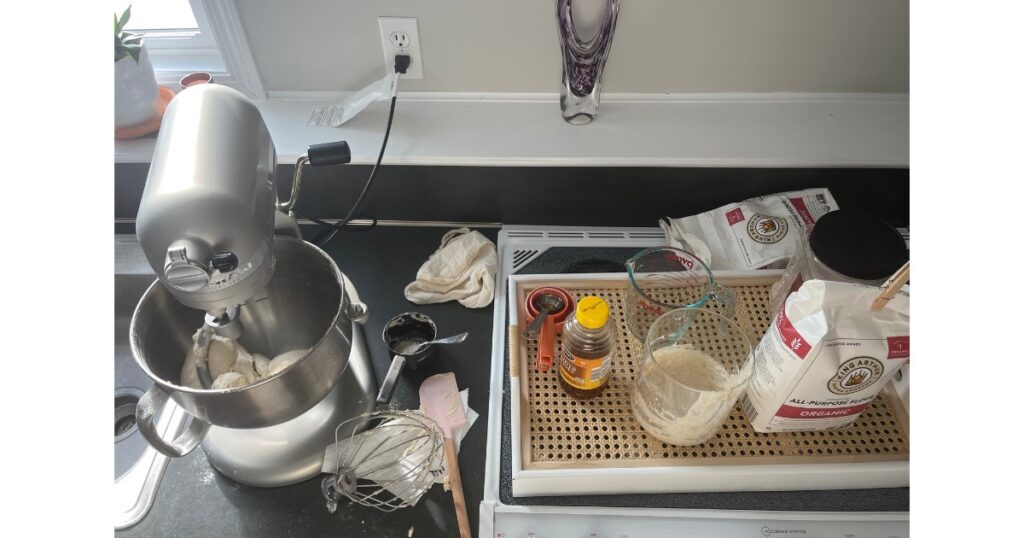
Ingredients for homemade sourdough bagels
To make a homemade sourdough bagel, there are a few basic ingredients needed.
- All purpose flour
- Feel free to substitute with bread flour, spelt flour or another white flour blend of your choice.
- Sourdough starter
- Active sourdough starter helps to make the bagels rise. No commercial yeast needed here!
- Sea Salt
- Honey (or maple syrup)
- Water
- Baking Soda (for the boiling water bath)
- Toppings (optional): poppy seeds, sunflower seeds, sesame seeds, everything but the bagel seasoning, onion flakes, nutritional yeast, cheese
- Add-ins (optional): dried blueberries, chocolate chips, sun-dried tomatoes
Kitchen Tools
Homemade sourdough bagels can be made by hand, though it might cause you to have a sick arm pump. The use of a stand mixer makes the process simpler by kneading the dough for you.
- Kitchenaid Stand Mixer
- I was torn between a tilt head and bowl lift kitenchaid mixer. We purchased a refurbished bowl lift mixer and it has held up great!
- Dough Scraper
- Silicone Baking Mat or parchment paper
- Beeswax wrap or plastic wrap
- Large pan (for boiling)
- Sheet Pan
- Reusable Plastic Bags (for storage)
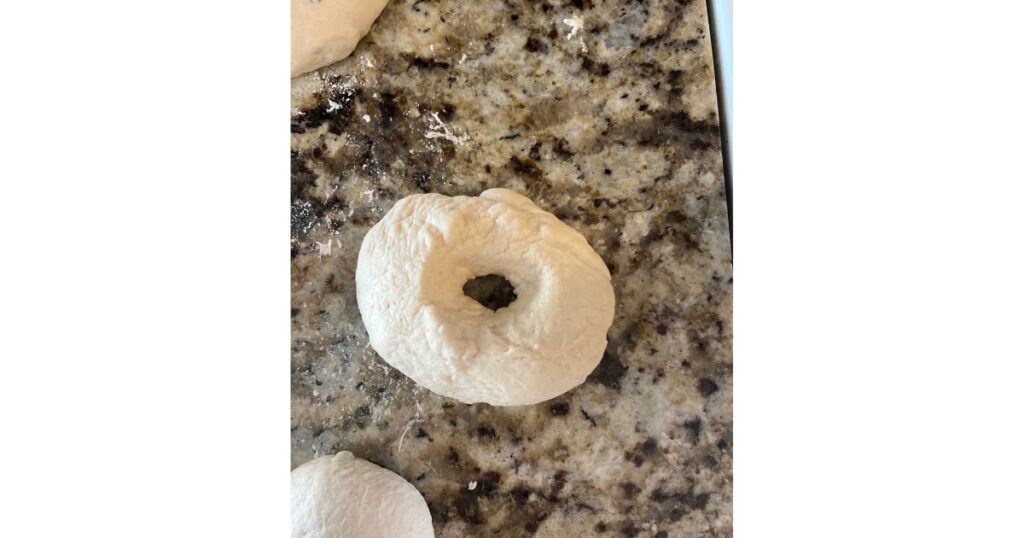
Baking Schedule – Part One
This recipe is highly adaptable to fit your baking timeline and desired fermentation level. We prefer a bulk fermentation on the counter and extend the process by placing the dough in the refrigerator overnight. The dough can be fermented for as little as 12 hours and as long as 48. (That’s the kind of flexibility I love as a mom!)
Firstly, the recipe starts by feeding your sourdough starter. This can take anywhere from 4-12 hours depending on the temperature of your home and if your starter is dehydrated, frozen, on the counter or in the fridge.
Once the sourdough starter becomes an active starter and has reached the peak, add all ingredients to mixing bowl. Allow to sit for 5-10 minutes before kneading with a dough hook attachment.
Allow mixture to combine for 10-15 minutes or until the texture of the dough is bouncy when pressed with your finger. When stretched, it may not pass the windowpane test which is totally fine!
Cover the mixing bowl with beeswax wrap, plastic wrap or a shower cap on the countertop for the first rise. The dough will rise in size, though it may not double.
Next, you can either move to the next part of the recipe (shaping and boiling bagels) or you can place the homemade sourdough bagel dough within the refrigerator to bulk ferment for up to 48 hours.
Baking Schedule – Part Two
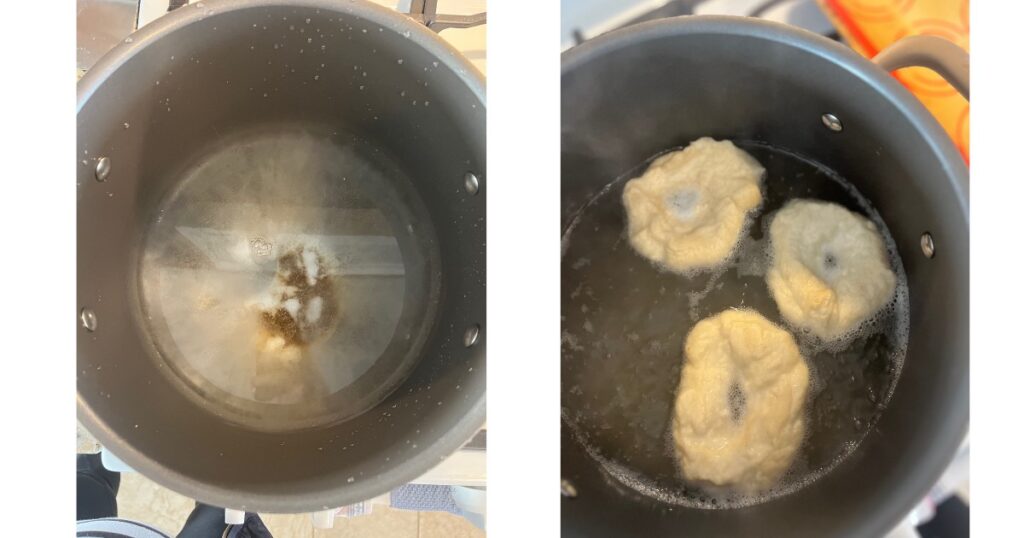
If the dough sat within the refrigerator, remove it and place the dough on the countertop to to allow it to come to room temperature. (This may be the next day). During this time, preheat the oven to 425 degrees and fill a large pot of water with water.
Allow the water to come to a boil before adding in baking soda and brown sugar.
As the bagel dough warms, separate into 8 to 12 balls. Make sure these are as close to equal pieces as possible.
You can use a kitchen scale for more accuracy. If making plain bagels (or flavoring on the top only), allow them to complete their second rise.
If making different flavored dough, place your add ins into the dough during this time. Knead and fold them into the dough and re-roll the dough into balls.
Once the large pot of water has boiled, use your index finger to push a hole in the center of the bagel. Place a few bagels into the water at a time. Allow them to boil for 2-3 minutes, flipping over halfway.
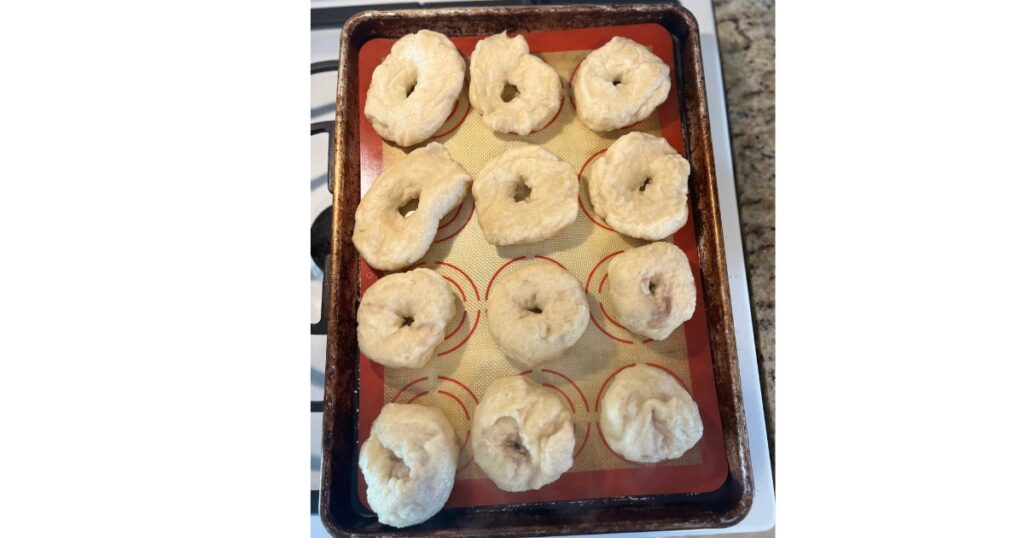
Remove from the water with tongs or a slotted spoon, being sure to shake excess water and blot with paper towel, if necessary. Place on a baking sheet, lined with parchment paper or a reusable cookie sheet. Repeat process until all bagels are complete.
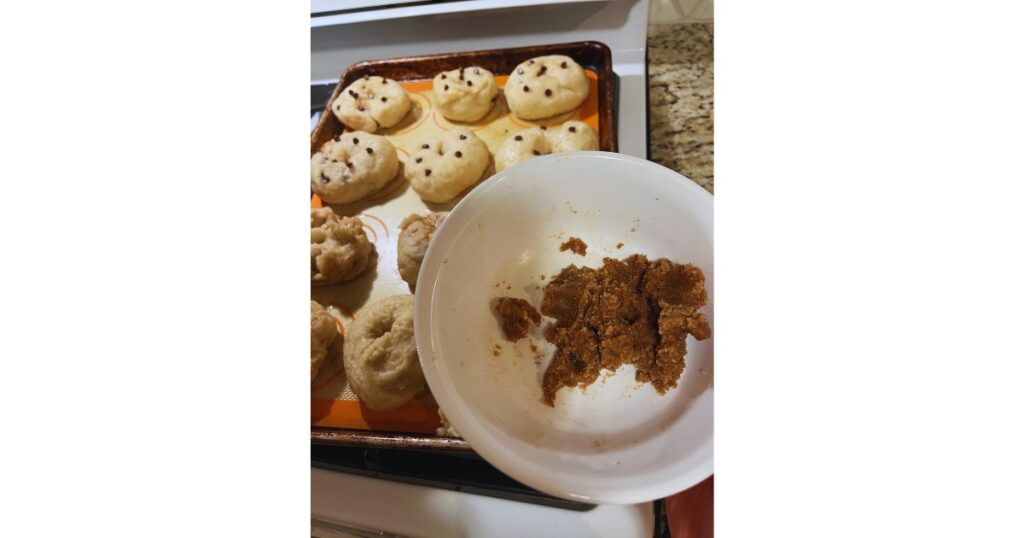
If placing a seasoning or cheese on top of the bagels, do so now. Cook for 20-25 minutes to allow the bagels to become golden brown in color. Finally, enjoy!
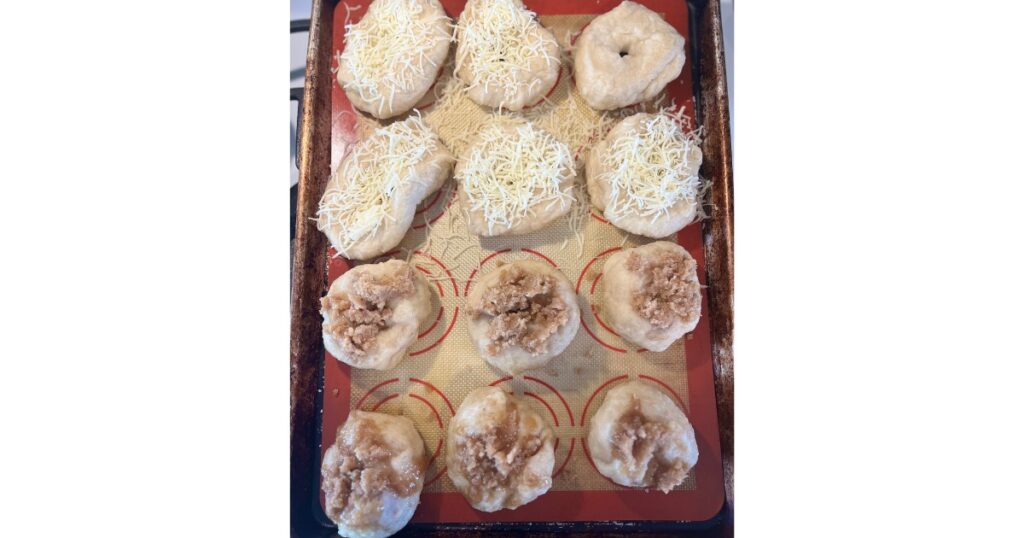

Frequently Asked Questions:
What are good bagel toppings?
There are a different ways to top a bagel. We like:
- avocado
- cream cheese and smoked salmon
- eggs and cheese
- peanut butter
- butter
- nutella
Why is my sourdough bagel not rising?
Sourdough bagel dough can be particular and can be affected by temperature, environment and hydration of sourdough starter. Because of this, ask yourself these questions to troubleshoot:
- Did your sourdough bagel dough rise enough?
- Was your starter under or past peak hydration?
- Did you incorporate the flour long enough?
- The dough should be bouncy when pushed after kneading.
How to store homemade sourdough bagels?
To store sourdough bagels, allow them to cool completely on a wire rack. If keeping on the countertop, put within a reusable ziplock bag for up to 3 days.
Make sure to keep the edge open to prevent the bagels from getting chewy or moist as they do release moisture.
Freeze the bagels for up to 6 months in an airtight container or freezer safe bag. I also recommend pre-slicing them before freezing for ease of reheating in a toaster, air fryer or microwave oven.
Why are bagels boiled before baking?
Boiling bagels helps to seal the exterior of the dough. It prevents the interior from leaking out and spreading across the pan. Additionally, it creates a crusty, outer layer on the bagel. Finally, boiling bagels begin cooking process before the bagels bake within the oven.
Why is brown sugar added to the boiling water?
Brown sugar does not flavor the dough. It acts as a way to caramelize the exterior. I would recommend placing brown sugar in the water even if you are making a savory bagel.

Homemade Sourdough Bagels
Equipment
- 1 Kitchenaid Stand Mixer Optional
- 1 Small Bowl
- 1 Pastry Cutter Optional
- 1 Large Pot
- 1 Sheet Pan Lined with parchment paper or a reusable mat
Ingredients
- 1 TBS Salt
- 3/4 Cup Sourdough Starter Active starter or sourdough discard work interchangeably
- 1-1/2 Cup Water
- 2-1/2 TBS Honey (or maple syrup)
- 5-1/4 Cup All purpose Flour
- 1 TBS Baking Soda (for baking soda bath)
- 1 TBS brown sugar (for baking soda bath)
Instructions
Step 1 – Fermentation (Countertop)
- Feed your sourdough starter and reserve some aside to use at peak.
- Mix the salt, active sourdough starter, honey (or maple syrup), water and the first three cups of flour together within the kitchenmaid mixer.
- Allow to sit for 5-10 minutes before mixing with a dough hook.Dough will knead for 10-15 minutes or until the texture of the dough is bouncy when pressed with your finger.
- Cover the mixing bowl with beeswax wrap, plastic wrap or a shower cap on the countertop for the first rise until doubled (or close to) in size.
- Next, you can either move to the next part of the recipe (shaping and boiling bagels) or you can place the homemade sourdough bagel dough within the refrigerator to bulk ferment for up to 48 hours.
Step 2 – Bulk Ferment, Boil Bagels and Cook in Oven
- If the dough sat within the refrigerator, remove it and place the dough on the countertop to allow it to come to room temperature. During this time, preheat the oven to 425 degrees and fill a large pot of water with water.
- Fill a large pot with water. Once boiled, add in baking soda and brown sugar.
- As the bagel dough warms, separate into 8 to 12 balls using a pastry cutter. If making plain bagels (or flavoring on the top only), allow them to complete their second rise.
- If making different flavored dough, place your add ins into the dough during this time. Knead and fold them into the dough and re-roll the dough into balls.
- Once the large pot of water has boiled, reduce the heat to a simmer. Using your index finger to push a hole in the center of the bagel. Place a few bagels into the water at a time. Allow the bagels to boil for 2-3 minutes, flipping over halfway.Remove from the water with tongs or a slotted spoon, being sure to shake excess water and blot with paper towel, if necessary.
- Place on a baking sheet, lined with parchment paper or a reusable cookie sheet. Repeat process until all bagels are complete.
- If placing a seasoning or cheese on top of the bagels, do so now.
- Cook for 20 minutes before reducing temperature to 350 for the last 5-10 minutes. The bagels will brown in color. Cool on a wire rack completely before slicing. Finally, enjoy!
Notes
- Use only all purpose flour, only bread flour or a mixture of both. The flour combination is flexible.
- Add additional toppings to the bagel as an inclusion or on top of the bagel.
What is your favorite flavor of bagels? Let us know in the comments below and …enjoy!



